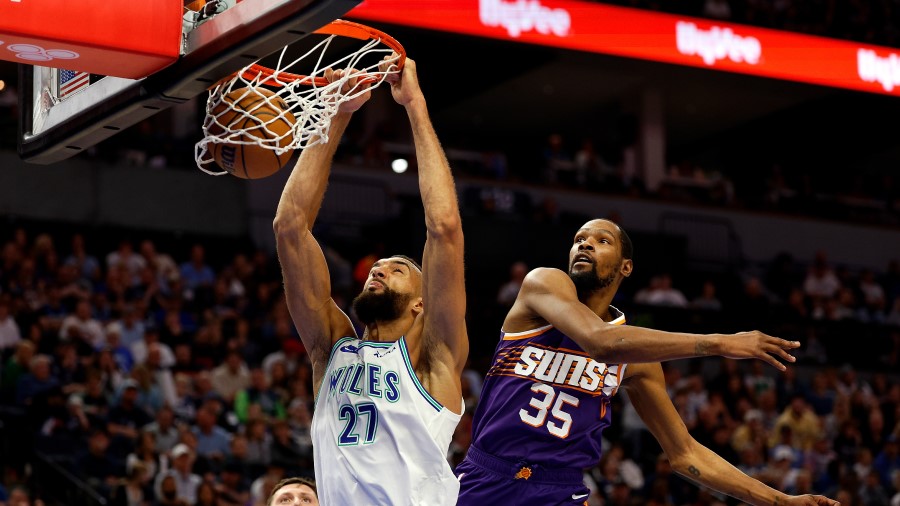Ed Davis: Utah Jazz Season In Review
Apr 10, 2020, 3:52 PM | Updated: Apr 24, 2020, 3:39 pm

New Utah Jazz center/forward Ed Davis talks to members of the media during a press conference at the Zions Bank Basketball Center in Salt Lake City on Friday, July 26, 2019. (Kristin Murphy, Deseret News)
(Kristin Murphy, Deseret News)
SALT LAKE CITY, Utah – The NBA is in a standstill as a result of the coronavirus outbreak that has sidelined professional sports across the globe. With 18 games left to play in the regular season for the Utah Jazz, and a date with the postseason on the line, it’s unclear when or if the season will return.
With game action in a holding pattern, it’s an ideal time to look at each player on the Jazz roster and how they have performed this season. Have they exceeded or failed to meet expectations, have they improved their game, remained steady, or seen a decrease in their level of play. Finally, how will they impact the team when games return, whether that’s to finish the 2019-20 season, or to begin the 2020-21 season.
The order of player evaluations will be done by jersey number, starting with the team’s lowest, and working to the team’s highest number.
Ed Davis – 17 – Center
Stats: 1.3 ppg, 3.8 rpg, 0.3 apg: .412%/.455%
Inarguably, Ed Davis has had the most disappointing season of any Jazz player based on expectations this year. Davis was signed to replace Derrick Favors as the team’s reserve center, a role in which he’d excelled with several teams during his nine-year NBA career.
Zion vs. Ed Davis pic.twitter.com/FEKpRYLY3B
— Dime (@DimeUPROXX) October 12, 2019
However, Davis’ game hasn’t clicked with what coach Quin Snyder has asked of him, and he’s since lost his rotation minutes to third-year center Tony Bradley.
Davis is averaging career lows in every major statistical category save steals per game, while having the most inefficient shooting season of his career. It’s been a bizarrely steep drop off from a player who has contributed to his former teams as a rebounder and hustle player, skills that traditionally translate wherever a player suits up.
Davis’ per minute averages have also dipped considerably in just one off-season, ranging from perhaps the best season of his career last year in Brooklyn to his nearly untenable play in Utah.
A large part of Davis’ dip in production is due to his poor fit within Snyder’s offense. With Joe Ingles running the offense off the bench before Jordan Clarkson joined the roster, the team was heavily reliant on Ingles ability to initiate the pick and roll.
Davis, however, is not a pick and roll player. The majority of the center’s scoring has traditionally come from putback scoring opportunities and hustle plays. The veteran in his 10th year lacks the size, hands, and finishing ability to excel predominantly as a rolling big man.
Until the team acquired Clarkson in late December, the entire bench unit struggled to compete with opposing second units. Between Ingles, Davis, Emmanuel Mudiay, Dante Exum, and Jeff Green, the Jazz bench featured a group that lacked any discernible identity.
Utah Jazz center Ed Davis has a fractured left fibula. The injury occurred against Sacramento. He will be reevaluated in 4 weeks.
— Jeremiah Jensen (@JJSportsBeat) November 2, 2019
To make matters worse, Davis suffered a fractured fibula in the sixth game of the season, causing him to miss 12 of the first 18 games of the season. In Davis’ absence, Bradley showed an ability to improve from game to game, while providing the team a release valve as a rim roller in the second unit.
Upon Davis’ return, the center continued to struggle with the second unit and was replaced in the rotation just one game after the team traded for Clarkson and waived Green.
Perhaps the redeeming factor in Davis’ season has been the professionalism he’s shown since being pulled from the lineup. The former North Carolina product hasn’t made any public statements regarding any unhappiness about his current role, nor did he request a trade before the NBA’s trade deadline.
Additionally, Snyder has praised the way Davis has mentored fellow Tar Heel Bradley in his new role.
🚨Tony Bradley with a THREE! 🚨#ThreesoftheWeek | @MountainAmerica pic.twitter.com/fer3N6lF7L
— utahjazz (@utahjazz) March 3, 2020
Davis is owed $5 million next season which makes his role with the team far more acceptable than it would be with a higher price tag. Even if Davis never returns to the rotation, his low cap hit is a reasonable insurance policy for emergency center minutes.
Even more likely, Davis’ expiring contract, mixed with his poor fit on the roster should make him a prime trade candidate for teams looking to add big man help without making a sizable investment.
Overall, Davis’ production with the Jazz has been a big disappointment considering the buzz that accompanied the signing over the summer. However, the veteran’s professionalism has prevented a potentially bad situation from deteriorating further and causing a rift in the locker room.
Ed Davis’ Letter Grade: D
You can read the rest of the 2019-20 Utah Jazz player evaluations in the links below.
Jordan Clarkson: Utah Jazz Season In Review
Joe Ingles: Utah Jazz Season In Review
















